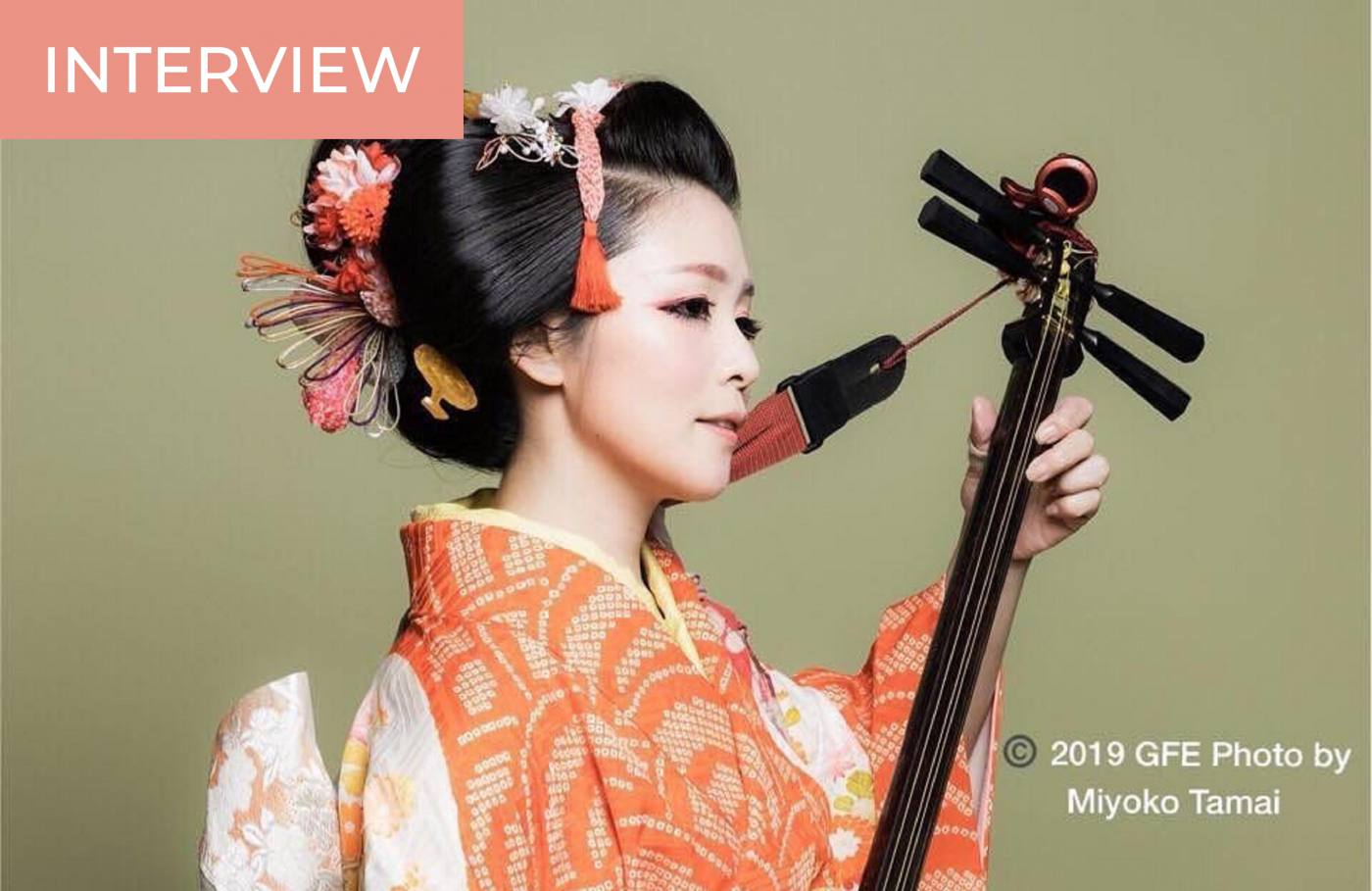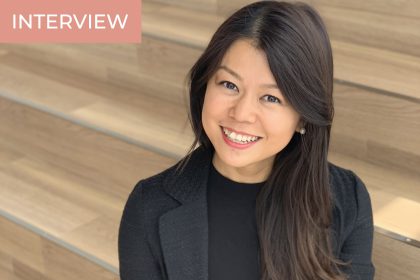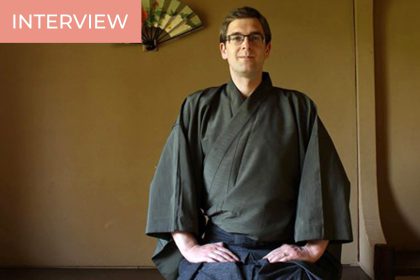Chie is a nagashi artist: her job consists of wandering the streets of Arakicho (a part of Shinjuku ward), going from tavern to tavern to play and sing to entertain the customers. She’s also a mangaka and draws people’s portraits while singing. I met Chie by chance at the Ringo no Hana tavern in Arakicho back in 2018, and we talked a little. Intrigued by her unfamiliar job and charmed by her out-going character, I asked if we could meet again and have an interview. At the time, I didn’t expect her story to be so moving,
The central part of this interview is a written transcript of what was originally a video interview made in Summer 2018 for the Tadaima Japan website (Kokoro’s ancestor site).
Becoming a ‘Singing Mangaka’
Dear Chie, could you please introduce yourself?
My name is Chie, the singing mangaka. I’m a nagashi artist walking the streets of Arakicho.
What exactly is a nagashi?
In older Japan, when there was no karaoke, no radio, no speakers, the nagashi would play music in taverns, or would sing for the customers. They were artists who would liven up the place. That’s what we call nagashi.
‘At first, I was a mangaka. But it was difficult to live from it.’

How did you become a ‘singing mangaka’?
At first, I was a mangaka. I would draw comics and write stories. But it was difficult to live from it. One day another mangaka introduced me to a nagashi master, Master Shintaro. Thanks to that, I became his disciple. But since I was also drawing, instead of just doing nagashi, I thought of this concept of singing and drawing, and started my career as the ‘singing mangaka’.
Learning to Play a Unique Instrument
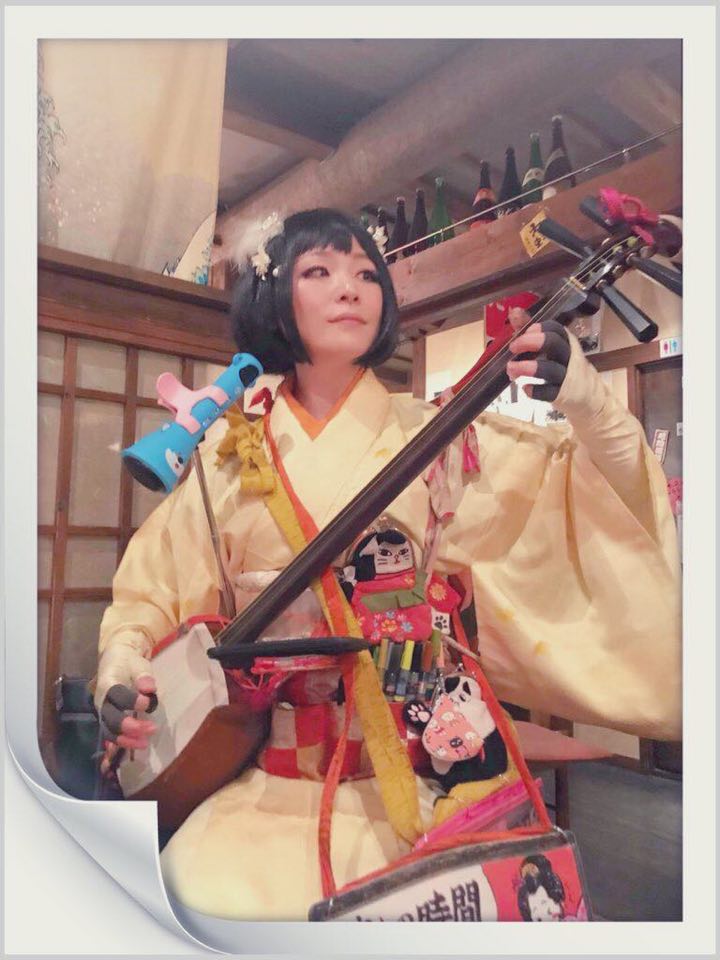
Could you tell us more about the instrument you’re playing?
When you look at it, it’s very similar to a shamisen. But there are four cords on this one instead of three. One day, in a used shamisen shop, I found one that someone had designed to play on stage. I was completely broken and it was impossible to play on it. I bought it for a very cheap price, and I asked a shamisen maker to make the same. It’s very unique. The main difference with a regular shamisen is that the extra cord makes a deeper note. The instrument’s sound has more force and depth. This is my companion when I walk the streets.
How long have you studied to play it?
The way to play my instrument is the same as a shamisen, and I take shamisen classes. I’ve started to walk around with it less than two years ago. At the start, I learned by myself. By watching videos, reading manuals… At first, I studied by myself, but I have a friend who play the tsugaru shamisen, so I have become their pupil, but I don’t only play music made for the shamisen. I also learn how to play Showa era pop music, western music, pop music… My friend teaches me how to play many different kinds of music.
‘My master told me “You must learn how to play an instrument so you can live.”’
It’s impressive to hear you play like this after only two years.
At first, I was walking around with my master who played the guitar. But he became sick, and unable to play. He told me ‘Pick up an instrument, whatever you like.’ And I was so motivated. He told me ‘You must learn how to play an instrument so you can live.’ When you’re put into a corner like that, you make extra efforts. At first, I could only play three songs, and I added more and more. Now I can play about 60. My master could play about 3000. So, in order to become like him, I train and train every day.
What’s the shamisen world like?
Actually, I don’t know so much about it. But here are many styles and genres: tsugaru shamisen, nagauta, kiyomoto… There are many genres, and each world is a very different world. I don’t know much about other genres. My teacher is playing tsugaru, but I don’t think too much about the different musical movements. What matters to me is the music and the instrument in themselves. I would like to be able to play everything, so I study to play all genres.
Inheriting Her Master’s Legacy
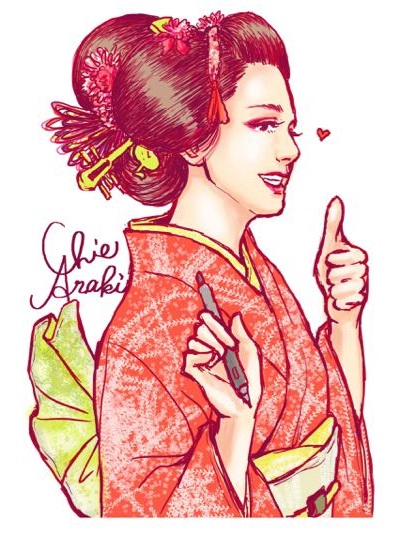
You also sing while drawing people’s faces. How did you learn to manage that?
As I said earlier, at first my master would play, and I would sing while drawing the portraits. I’m alone now, and I can’t draw and play at the same time. So, I use a portable karaoke, I sing, and I draw. The origin story is that my master started forgetting his lyrics because he was getting old. In the very beginning, he would sing and I would draw. But he started getting old, and kept forgetting the lyrics, so I ended up singing everything. He would only play the guitar. There was no other way… It’s the same reason I learned how to play the shamisen. It was a necessity. We didn’t have the choice.
‘My master’s legacy is why I will do the nagashi for the rest of my life.’
And now you’re doing this on your own…
Yes. My master got sick and passed away last year. He was doing the nagashi until the day before being hospitalized. He would play the guitar in his hospital room, waiting for the day he would come back here. But he couldn’t overcome his old age. I have inherited being in this town, his customers, his relations with the shop owners. It’s his legacy and I’m doing my best to return him this favor. That’s why I will do the nagashi for the rest of my life.
What does this town, Arakicho, mean to you?
It’s a town where traces of the older Japan remain, where people are warm and care for one another, like the women who tend the bars. Most of the customers are very gentle. It’s because it’s town like this, that even if my master had done the nagashi in many places all over Japan, in the end he came back here. He stayed here until the end. It’s because of people’s gentleness, that it’s a town you want to come back to. And even when I walk the streets all alone, I can feel it. Whatever happens, someone will help me. It’s a wonderful town.
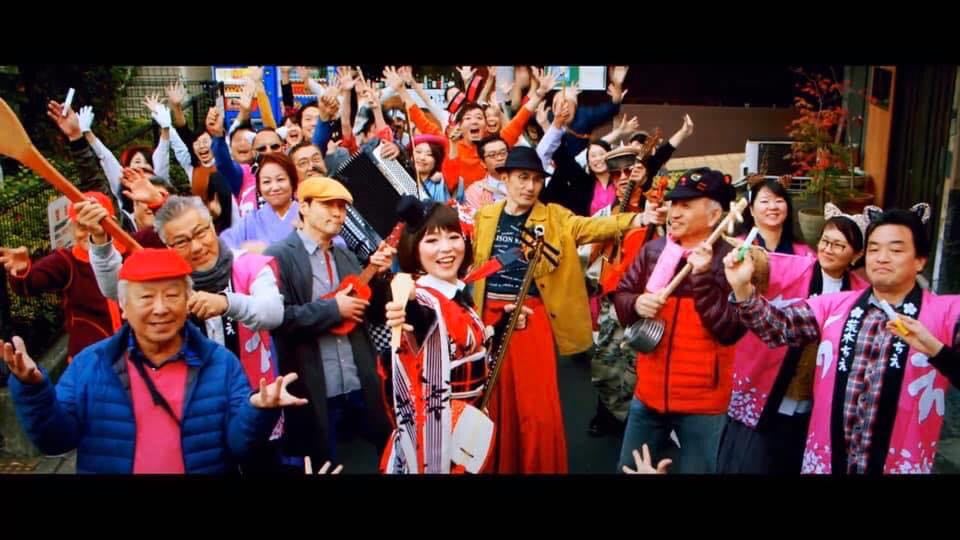
‘When I bring joy to customers, I’m really glad I chose this job. ‘
What are the hard parts and the happy parts of being a nagashi?
The hard part is, every day I visit a lot of places. In the Summer, inside the taverns it’s fresh, but outside it’s hot. In Winter, inside it’s warm, but outside it’s freezing. Because of the differences of temperature, it’s easy to get sick. I have to be very careful about my health. For example, I do hot yoga, I work out, I cook my own meals. I try to keep a healthy body.
The thing that makes me the happiest is the customers. When they wait for me, or call for me. People would say ‘I came all the way from Hokkaido just to see you’. In such moments when I bring joy to customers, I’m really glad I chose this job.
This kind of customers who come all the way from very far, did they get to know you from social medias?
Some people get to know me through social media, but here are also my master’s long-time customers, people who get to know me by word of mouth. Some people would meet me because their friend introduced them to me, and then they would come to see me on their own. It’s people relations, but not only through social media.
Speaking of social media, every day you post pretty pictures of yourself wearing different outfits on your Instagram and Facebook accounts. How do chose these outfits?
First, according to the weather. When it’s raining, I wear western clothes. I wear Showa era clothes, some kind of vintage fashion. When it’s not raining, according to the season, I wear a kimono or a yukata. In winter I wear a kimono with two layers. Regarding the colors and the hair ornaments, it depends on my mood of the day. I love making my own things and I often make my own accessories. Most of my kimonos are presents from other people. They would offer it to me saying ‘This was my grandmother’s beloved kimono.’
What are your challenges for the future?
Now I play Showa-era pops or old songs, I play songs that already exist, but I’d like to add my personal songs. Of course, I can make my own songs, but I hope to create music with a lot of different people,
A Lot Happened Since Then
Republishing this interview was a good opportunity to contact Chie and have a look back at what happened in her life since Summer 2018. And there is a lot!
Dear Chie, thank you for allowing us to publish your interview on Kokoro. I think there were many significant events happening in your life since then. Could you tell us more?
Yes, a lot of things have changed since we did this interview together. But the most significant even is that I released my first CD! In the interview, I told you I wanted to create my own songs, and my wish was granted. The famous Kei Ogura produced the lyrics and the music, and it was released on CD in July 2019. It’s called ‘Nakanaiyo’ [I don’t cry]. We even released a music video and it’s also been released on DAM karaoke machines last June!
You changed your artist’s name too.
Yes. I used to be ‘Chie, the singing mangaka’ but now I am ‘Araki Chie, the singing mangaka’. Mister Ogura named me like this to convey the meaning that I am Chie from Arakicho
2020 is a very challenging year. How has it affected your nagashi career?
I’ve been self-distancing since the end of March because of the Coronavirus. What I mainly do now is that I draw portrait and sell them online. I’m glad to have many fans who order their portraits to support me. By the way, one of my supporters has volunteered to open an Araki Chie Fanclub during this year! I’m very grateful and I’m looking forward to it.
Chie’s official fanclub has opened on July 7 under the name “Chie fun kurabu ~ ohinerisuto no kai~“. There you can find the latest information about her, videos merchandise and much more (Japanese language only).
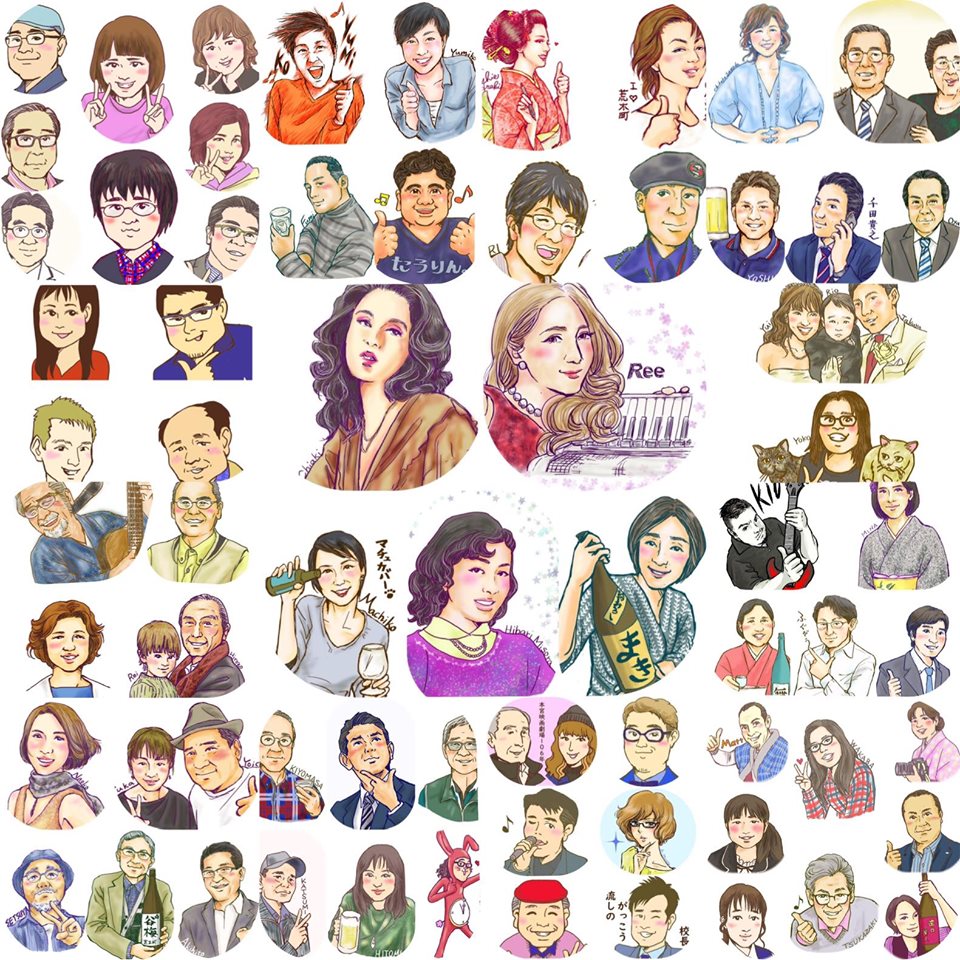
A Story of Being Rewarded for Resilience
There is a verb specific to the Japanese language and culture that you may have heard before: ganbaru. There is no exact equivalent in English for it, but it englobes the meanings of ‘making efforts’ or ‘doing your best.’ For Japanese people, it’s almost a value in itself, and it will often come up in daily conversations. The essence of the ‘ganbaru’ concept lies not in the effort in itself, but rather in the state of mind of the person who does them. When a Japanese person says ‘ganbaru!’, what they mean in essence is ‘Ok. I’m gonna do this. Bring it on.’
It’s a word that Chie had used many times during my interview with her back in 2018. Especially when she related how she had to improve her musical abilities to continue making a living. ‘When you’re put into a corner, you ganbaru,’ she told me. Her master forgets the lyrics, so she has to master drawing while singing at the same time? She learns how to do it. She has to learn an instrument quickly so she can keep doing the nagashi on her own? She does it.
She kept going outside working in all kinds of weather, even if sometimes it took a toll on her health. When the Coronavirus stroke, she found a way to remain close to her fans by adapting her activity to the new situation.
‘I had no choice’ are other words that came back several times in the interview, but, in my opinion, Chie had a choice. Anytime, she could have decided to stop her artistic career and do anything else. But she didn’t. She stayed resilient in front of all the difficulties, finding strength in her bond with her master, and support in the legacy she received from him: the art, the town, the people.
Chie never complains, but I can imagine there were some tough times to go through. But her evolution since then proves she was right to keep going: she braved the storm, and she was rewarded with her wish come true. Her resilience and good character have opened the door to wonderful opportunities: working with a famous music composer and producer, releasing a CD, getting her name known to a large audience.
For us, living in 2020, Chie’s embodiment of Japanese-style resilience is an inspiration.

